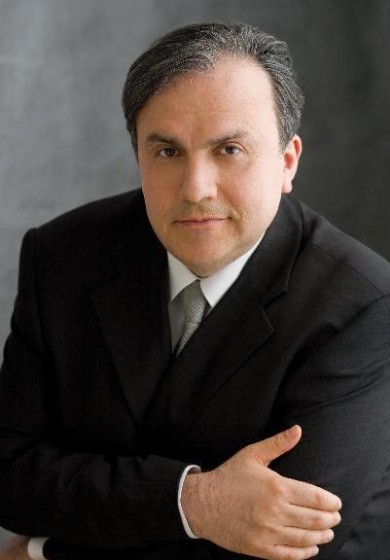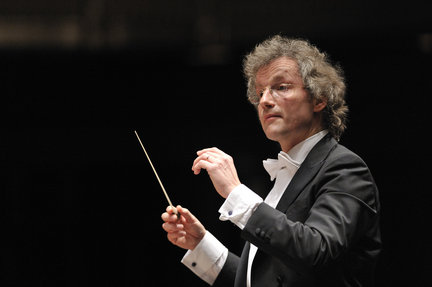Cleveland Orchestra, Bronfman open Miami season with power and precision

Yefim Bronfman performed Brahms' Piano Concerto No. 2 with Franz Welser-Möst and the Cleveland Orchestra Friday night at the Arsht Center.
The Cleveland Orchestra has returned to the sunshine, fresh audiences and deep-pocketed donors of South Florida, opening the sixth season of its Miami residency Friday with one of its finest performances of the past few years.
The orchestra’s choice of works in 2012 represents a more adventurous approach than the stodgy programming of last season, with rarely heard works and compositions by two living composers showing increased confidence in the sophistication of Florida audiences. So successful has the residency been that the orchestra is considering expanding it from three weeks to four. January is certainly a good month to get out of Cleveland (Saturday forecast: Clouds, snow flurries, a low of 24 degrees) and the orchestra gave a full-blooded performance Friday at the Arsht Center for the Performing Arts that more than earned it a few days in the South Florida sunshine.
The pianist Yefim Bronfman joined the orchestra for the first work on the program, Brahms’ Piano Concerto No. 2. Anyone who attends concerts regularly will have heard this work several times, but rarely will you hear it played with the vigor, precision and power that the Cleveland ensemble, Bronfman and music director Franz Welser-Möst brought to this performance.
Bronfman is a brilliant pianist who can do whatever he wants at the keyboard, and what he wanted to do in this case was use his technique for a weighted, emphatic performance that never allowed difficult rapid passages to dissolve into show-offy virtuosity. His playing was delicate, fluid and virtually frictionless in the dance-like second theme, yet he also drew great power, richness and weight from the piano where Brahms expects it to stand up to orchestra.

Franz Welser-Möst Photo: Roger Mastroianni
This work is among the most symphonic of concertos, and the orchestra matched Bronfman in the power and intensity of its performance. Welser-Möst whipped up exciting tuttis in the first movement, as violins ascend in dramatic climaxes. Horn playing was evocative and immaculate in Brahms’ broad melodies. Principal cellist Mark Kosower gave a lofty, noble account of the third movement cello solo, his playing warm but never syrupy.
The only complaint was that ushers were still seating people when the performance began; after the first movement ended, they continued to allow in a flood of latecomers, so in the first minutes of the second movement, Bronfman and the orchestra had to compete for attention with the whispers and clicking heels of people finding their seats.
After intermission came the young composer Sean Shepherd’s Wanderlust, a three-part work inspired by the Nevada desert, the English coast and Bilbao, Spain. Although the titles imply this is an atmospheric work intended to evoke different landscapes, it was difficult to get a feel for these areas from this ominous, dissonant, richly orchestrated music. In the English section, called “Seagulls on High,” there wasn’t much sense of either England or seagulls. But what this music has that many contemporary works do not is a firm sense of pacing and urgency. The final section, for example, builds to a moment of great catharsis, with a powerful crisis in brass and percussion before a calming passage in the winds.
Shostakovich’s Symphony No. 6, composed in the late 1930s, is heard much less frequently than the popular symphony that preceded it. While it doesn’t have the Fifth’s strong sense of structure, it is a gripping work that should be heard more often. The opening Adagio is among the composer’s darkest compositions, which is saying something. It unfolds with a sort of grim formality, with old-fashioned elements such as pedal points (long-held low notes under a melodic passage), trills and counterpoint rooting Shostakovich’s astringent harmonies in the past.
Welser-Möst gave a broadly conceived performance that allowed Shostakovich’s music to speak for itself, with few changes in tempo or other elements that would have drawn attention to the interpretation. Under his baton, crescendos took minutes to unfold, as the orchestra gradually expressed the work’s power, with tremendous, sonorous playing in the strings. The winds did a particularly inspired job with the bleak solos over long-held notes in the orchestra.
After the restraint of the first movement, Welser-Möst unleashed the orchestra for a wild burst of energy in the ensuing Allegro, allowing Shostakovich’s manic side full rein. The final movement was notable for violin playing of great transparency and lightness.
The Cleveland Orchestra repeats the program 8 p.m. Saturday at the Arsht Center for the Performing Arts in Miami. The concert will also be broadcast live on WCLV-FM Cleveland. arshtcenter.org, 305-949-6722.